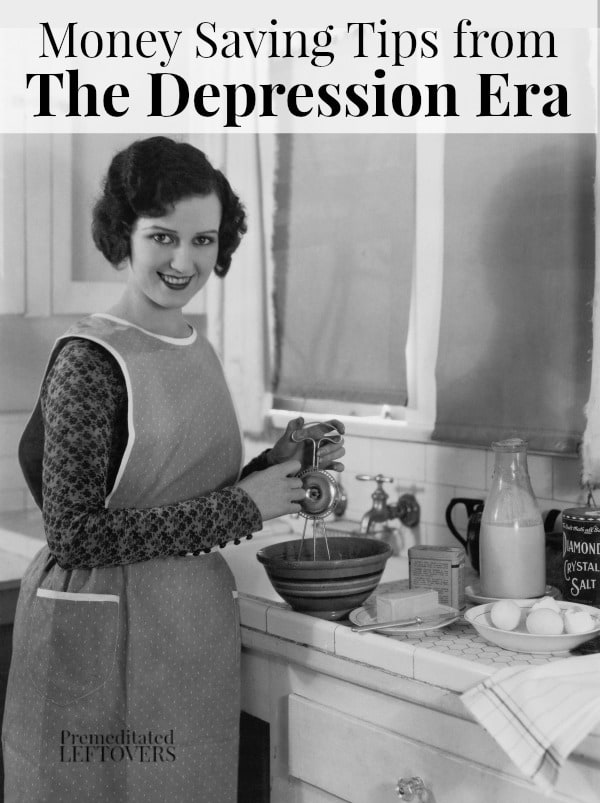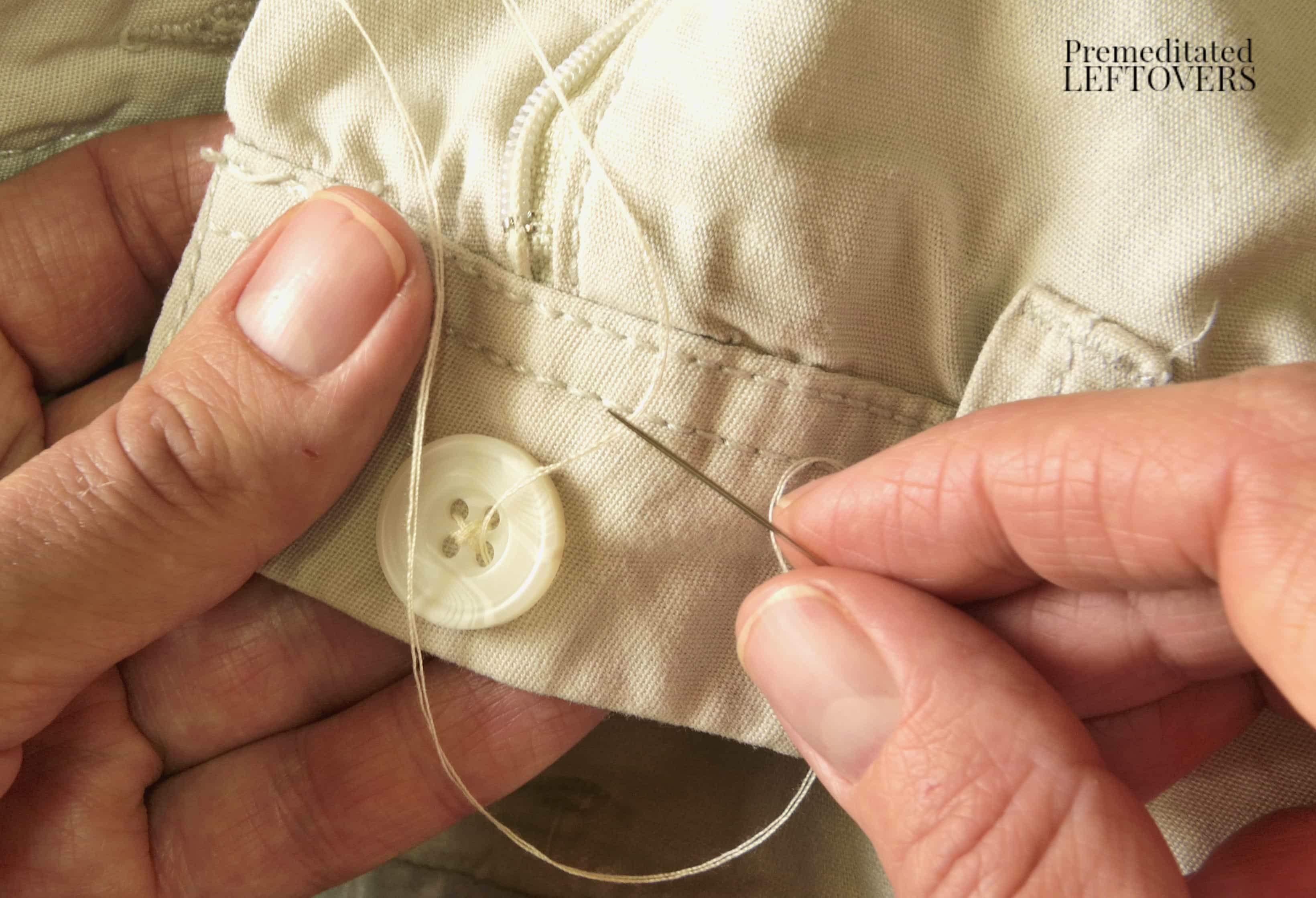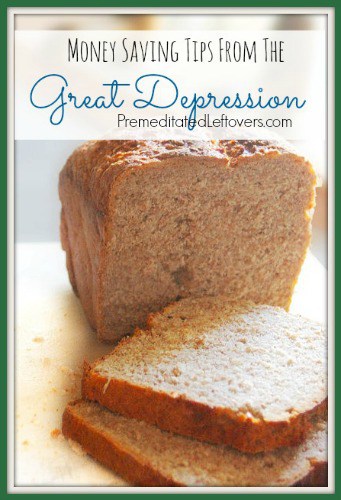These money saving tips from the Depression Era can still be used today to help you can save money in practical ways.
Most everyone knows that during the Great Depression people had to look for ways to save every penny they could. Some of these ways are hard to apply to today, but many of the money saving tips from the Depression Era can be used today.
Money Saving Tips From the Depression Era
Make your own bread and other convenience foods. There were very few convenience foods in the depression-era. People made what they used from scratch for the most part and buying bread was very rare. This money saving tip is something that can be applied to today and will save you a bundle. Here is an easy rustic French bread recipe to get you started. What convenience foods do you buy? Search for a homemade recipe. You may find that making the item from scratch doesn’t take that much more time.
Money Saving Cooking Tips from the Great Depression:
How to Build a Depression Era Pantry
Filling Depression Era Breakfast Recipes
Frugal and Flavorful Depression Era Recipes
Depression Era Tips to Stretch Your Food Budget
Find free fun. The library has movies, books, music, and classes in many communities. You may even get lucky and live near a library that is almost like a community center offering free concerts, free movies with popcorn and craft activities. Many local museums have one day a month that they are free to the public. There is no reason to spend money on entertainment when there is so much to do for free.
Learn to sew and stop throwing out clothes that have holes or are missing buttons. During the great depression, people often only had 1-2 outfits. They had to make do with this meager wardrobe so they sewed things up as many times as they could as well as made a lot of their clothing. It might be worth the investment to be able to sew like this so be sure to take a class or two if you don’t know how. Here are tips for saving money on fabric and sewing supplies and here are resources for free patterns.
Use cloth instead of paper. There was also no such thing as paper napkins, paper towels, disposable diapers. Women made their own napkins, used rags, and new moms made their own cloth diapers. While most of us wouldn’t want to make our own diapers, it is still possible to save money by using cloth in place of paper products. Here are 5 easy ways to use cloth instead of paper products. And here are tips for how you can save money using cloth diapers.
Grow your own food whenever you can. Not all people lived out in the country during the great depression, but most people grew what they could on window sills, in buckets on balconies and where ever they could find to space to grow produce in an urban garden. Gardening today can still save you a lot if you focus on growing the more expensive vegetables. Here are tips for growing vegetables in a container garden.
Before you throw something out, think about if it can be used for something else. We have grown so accustomed to tossing things when we are done with them that we have almost lost the very fine art that most households possessed of reusing everything that can be reused. While you don’t have to go to the extreme of using cardboard boxes cut into sole liners for your shoes, you can reuse many things you toss out without thinking. Here are 5 Things You Can Reuse in Your Home.
Be willing to lend a hand. Neighbors helped neighbors during the great depression. Because services were very hard to pay for, people helped each other with what their talents were. If you know someone who is good with sewing, maybe trade services with them if you are good at baking bread or cutting hair. When you help each other, you keep expenses down.
Use up everything until it is absolutely gone. Don’t toss out that toothpaste tube until you get all of the remaining product out. Add a little water to an almost empty jar of dressing, barbecue sauce, or jam to make a marinade. Stop buying things in every color. Be conscious of your consumer ways and really give yourself a reality check if you think you need to buy more of something that still works or that you haven’t used up.
Go back to basics with cleaning supplies. Vinegar and baking soda will do most cleaning jobs around your home. The best part about these two natural cleaners is, they are both very low cost. Here are 5 easy and frugal homemade cleaners.
Question the necessity of every purchase. While the above tips may seem small, start adding up how much you spend eating out, and buying convenience foods. Just switching to cooking at home can add up to a savings of several hundred dollars a month. Look over your receipts. How much are you spending on paper products? cleaning products? How much is wasted on buying something new, when you could have fixed or repurposed an old item? Those who lived through the Great Depression questioned every expenditure, we would be wise to do the same!
More Frugal Tips from the Great Depression
Depression Era Jobs to Make Extra Money
Frugal Household Hacks from the Great Depression
Depression Era Health and Beauty Tips You Can Still Use Today
8 Forgotten Depression Era Money Saving Tips
Frugal Beauty Tips from the Great Depression
More Money Saving Tips
- How to Get Started Couponing
- 10 Secrets of Frugal Shoppers
- How to Avoid Supermarket Spending Traps
- 10 Ways to Save on Groceries without Using Coupons
This was originally published on February 26, 2014. It was updated on July 24, 2017.





Laura says
So fascinated with the frugality of the depression era way of doing. Wish I knew more!
Julie says
Sewing clothing, home necessities, gifts, etc., is often more about quality than cost. Patterns can be had for $1 on sale. You can spend as much or as little as you want on fabrics or get creative and use sheets or other imaginative sources. (Check out an “Altered Couture” magazine for inspiration!) If you usethe best materials you can afford/find, you will end up with a better fitting and constructed, longer lasting product than the cheap, disposable fashions available today. Plus, sewing has been shown to reduce stress!
Marion Rodriguez says
Tambien cuando mis hijos eran pequeños hice mucha ropa para ellos y ahora que tengo una niña despues de los cuarenta mi entusiasmo es mayor aqui en uruguay la ropa es muy cara y las telas esta un poco mas barato
Alea Milham says
That’s awesome! I enjoy sewing as well and when I can find a deal on fabric it is much less expensive.
Annie says
When my children were young, I made all their pj’s, underpants, t-shirts, shorts etc using repurposed fabric from thrift shops. Dresses with full skirts, large t shirts, shift dresses all have large amounts of fabric without seams which can be cut down for yard clothes. Hand knitted sweaters can be unravelled and the wool reused. Sometimes I would dye the wool a different colour, my boys weren’t fond of pink!!!
karen segal says
patterns are $1 at our Fabric store a few times a year. and I get them at good will. Sometimes fabric at tag sales.
Jessica says
Cloth disappearing is a wonderful thing! Using cloth sanitary napkins is also depression era, friendly to the environment and a huge cost savings! They are also a LOT more comfortable!
Ducks n a Row says
Great tips. Even if the whole economy isn’t there, many people go through their own financial “depressions” and this advice will be a huge help.
What I like to keep mindful of is that everything is a season. Though you may be in a long, tough time, it is not forever. Keep believing, working hard and know there is a brighter day coming.
Sinea
catherine says
I agree with you stephanie on the clothes making thing…and my son never really appreciated my smocking and embroidery all that much anyway (grin)…but you can save tons of money on anyone out of mainstream…my son was 6’5″ by the time he was 12. I am a larger than life size and even underwear is more expensive in larger sizes. Prom or party dresses are so steep…you can save a ton by making those. Simple things like jammies and gowns and swim suit cover ups and simple dresses are quite a bit cheaper to make too. I feed my food that is too far gone to the chickens and then use their poop on the garden. Circle of life or something…
Stephanie says
I got so fed up with the bits of lotion being left in the bottom of plastic bottles that I bought a cheap serrated knife. I hack open the bottle when I get to the end and get at least two or three more days out of it. We also don’t throw away food–unless it’s so far gone, it’s not safe to eat. But usually it’s been repurposed into a quesadilla or fried quinoa by then!
The only thing I don’t find to be a savings is sewing. Clothes can be bought so cheap now. I’ll patch holes, but by the time I buy fabric and other materials, I could have bought the kids whole outfits at Old Navy.
Mila says
Patterns and material are so expensive. Wise shopping beats making clothes. I stopped seeing a long time ago.
Martha Matthews says
I buy new patterns at Thrift stores take them home and iron fusible bonding to the pattern. Open the pattern envelope and tape iit to a large manilia evevelope and put the pattern inside. I have patterns that are 10 years old. I look for fabric at yard sale. I love to sew.
Jim says
I agree with the sewing. I look for sales (clearance) it seems to be cheaper than purchasing material and buttons etc to make it!
Linda Thomson says
I absolutely agree with ALL of your suggestions! As Americans we buy too much and then throw it all away. Cooking from scratch is not that hard. We all could use a little practice in making do with less.